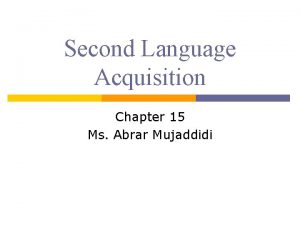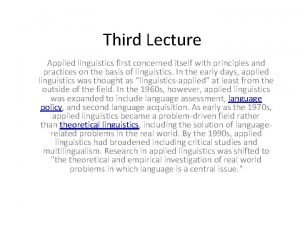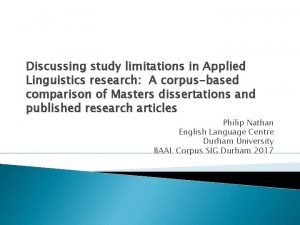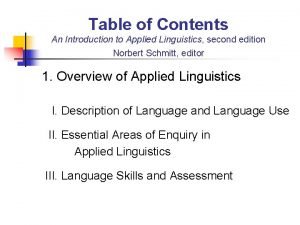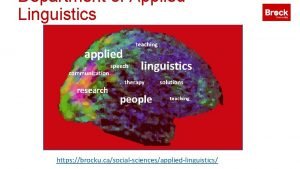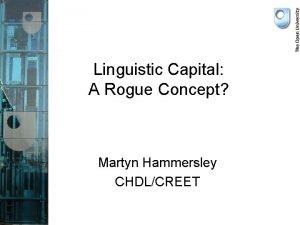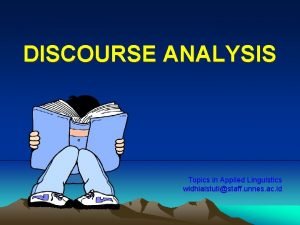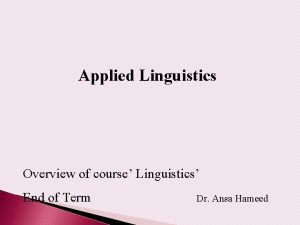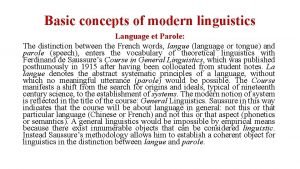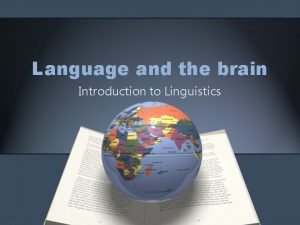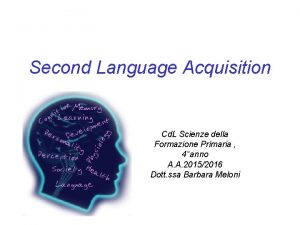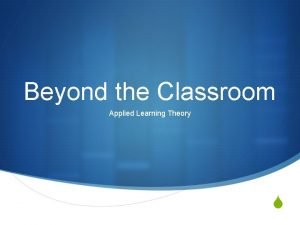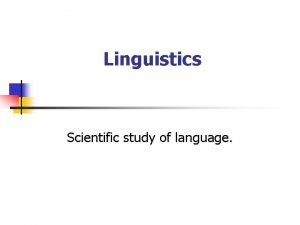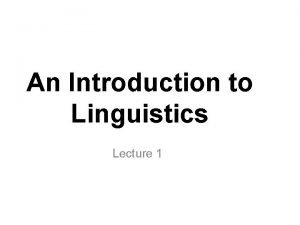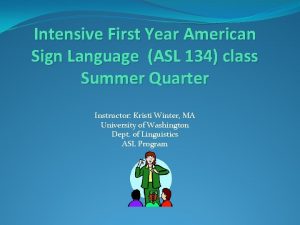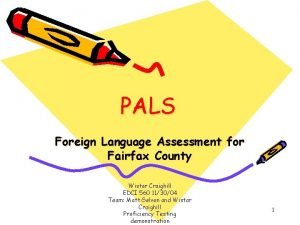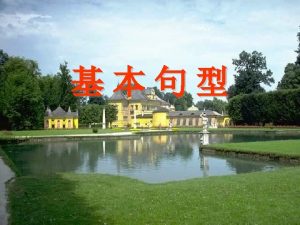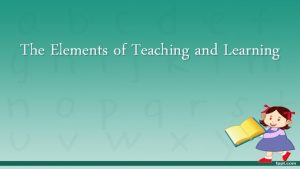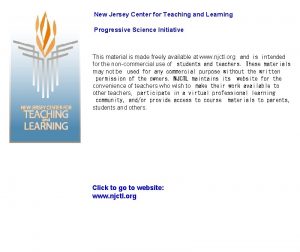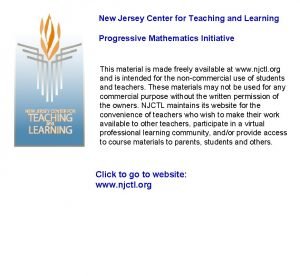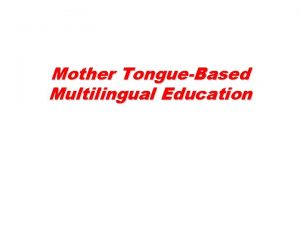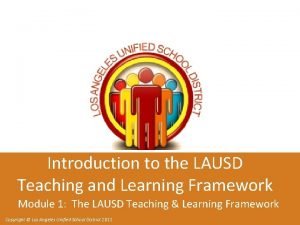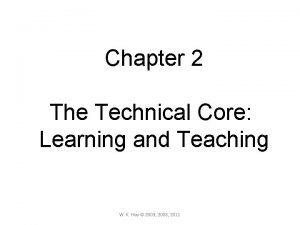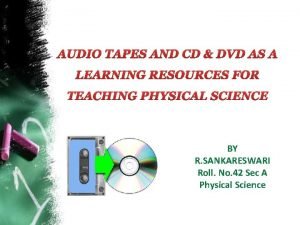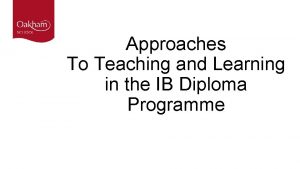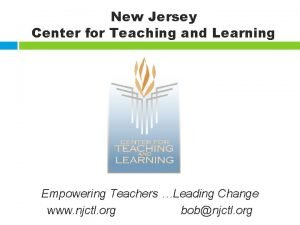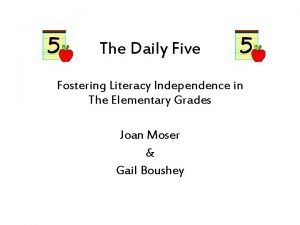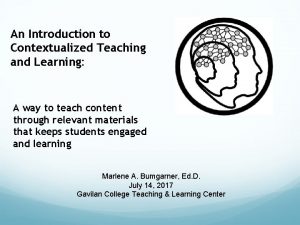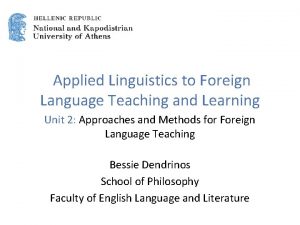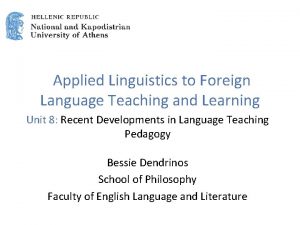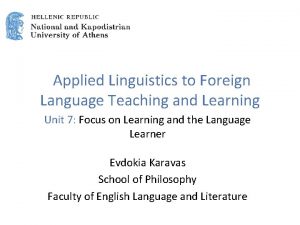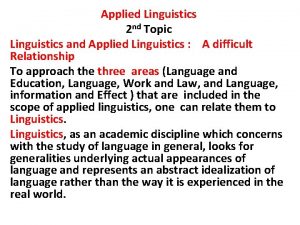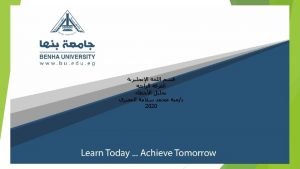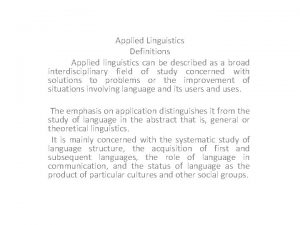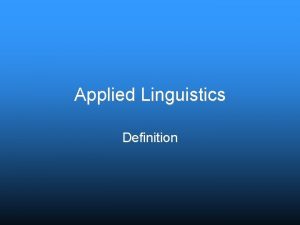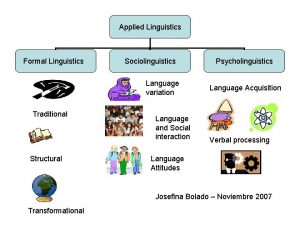Applied Linguistics to Foreign Language Teaching and Learning







































- Slides: 39

Applied Linguistics to Foreign Language Teaching and Learning Unit 1: An Introduction to Applied Linguistics Evdokia Karavas School of Philosophy Faculty of English Language and Literature

Main issues of this unit • What is linguistics? • What is the relation between linguistics and applied linguistics? How do they differ? • What is applied linguistics? • When did applied linguistics develop as an independent area of study? • What are the main areas of concern of applied linguistics? • What will this course focus on? How is this course organised? An Introduction to Applied Linguistics 2

What is Linguistics? (1/2) • Linguistics is the scientific study of language. Linguists do work on specific languages, but their primary goal is to understand the nature of Language in general. • Linguistics is primarily concerned with the nature of language and communication. There are broadly three aspects to the study, including language form, language meaning, and language use in discursive and communicative contexts. An Introduction to Applied Linguistics 3

What is Linguistics? (2/2) • Linguistics deals with the study of particular languages, and the search for general properties common to all languages or large groups of languages. An Introduction to Applied Linguistics 4

Some questions linguistics tries to answer (1/2) • What distinguishes human language from other animal communication systems? • What features are common to all human languages? • How are the modes of linguistic communication (speech, writing, sign language of the deaf) related to each other? An Introduction to Applied Linguistics 5

Some questions linguistics tries to answer (2/2) • How is language related to other types of human behaviour? • What is language and how is it organized? • How is it analysed? How are its units discovered and tested, etc. An Introduction to Applied Linguistics 6

Branches of linguistics Pragmatics Phonology Semantics LINGUISTICS Phonetics Syntax Morphology An Introduction to Applied Linguistics 7

What is Interdisciplinary Linguistics? Interdisciplinary studies involve two or more academic disciplines which are considered distinct. The most common interdisciplinary branches of Linguistics are: An Introduction to Applied Linguistics Historical Linguistics, Sociolinguistics, Psycholinguistics, Ethnolinguistics or Anthropological Linguistics, • Computational Linguistics, • Neurolinguistics. • • 8

Applied Linguistics: When did it all begin? (1/2) • The term Applied Linguistics (AL) is an Anglo. American coinage. • It was founded first at the University of Edinburgh School of Applied Linguistics in 1956. • Then at the Center of Applied Linguistics in Washington D. C. in 1957. An Introduction to Applied Linguistics 9

Applied Linguistics: When did it all begin? (2/2) • The British Association of Applied Linguistics (BAAL) was formally established in 1967, with the following aims: “the advancement of education by fostering and promoting, by any lawful charitable means, the study of language use, language acquisition and language teaching and the fostering of interdisciplinary collaboration in this study” (BAAL, 1994). • It was largely taken for granted in the 1960 s and 1970 s that applied linguistics was about language teaching. An Introduction to Applied Linguistics 10

What is Applied Linguistics? (1/4) • Applied Linguistics entails using what we know about language, about how it is used, and about how it is learned in order to solve some problem in the real world. • Applied Linguistics uses language-related research in a wide variety of fields (e. g. language acquisition, language teaching, literacy, gender studies, language policy, speech therapy, discourse analysis, censorship, workplace communication, media studies, translation, lexicography, forensic linguistics). An Introduction to Applied Linguistics 11

What is Applied Linguistics? (2/4) “AL is the utilisation of the knowledge about the nature of language achieved by linguistic research for the improvement of the efficiency of some practical task in which language is a central component. ” (Corder, 1974, p. 24) An Introduction to Applied Linguistics 12

What is Applied Linguistics? (3/4) “Applied Linguistics is using what we know about (a) language, (b) how it is learned, and (c) how it is used, in order to achieve some purpose or solve some problem in the real world” (Schmitt & Celce-Murcia, 2002, p. 1). An Introduction to Applied Linguistics 13

What is Applied Linguistics? (4/4) “The focus of applied linguistics is on trying to resolve language-based problems that people encounter in the real world, whether they be learners, teachers, supervisors, academics, lawyers, service providers, those who need social services, test takers, policy developers, dictionary makers, translators, or a whole range of business clients. ” (Grabe, 2002, p. 9). An Introduction to Applied Linguistics 14

Defining characteristics of Applied Linguistics • Autonomous, multidisciplinary and problem solving: uses and draws on theory from other related fields concerned with language and generates its own theory in order to find solutions to language related problems and issues in the real world. • Practical concerns have an important role in shaping the questions that AL will address. • Language related problems concern learners, teachers, academics, lawyers, translators, test takers, service providers, etc. An Introduction to Applied Linguistics 15

What problems are related to language? Problems related to: • language learning, • language teaching, • literacy, • language contact (language & culture), • language policy and planning, An Introduction to Applied Linguistics • language assessment, • language use, • language and technology, • translation and interpretation, • language pathology. 16

A sample of questions Applied Linguistics addresses (1/2) • How can we teach languages better? • How can we diagnose speech pathologies better? • How can we improve the training of translators? • How can we develop valid language examinations? An Introduction to Applied Linguistics 17

A sample of questions Applied Linguistics addresses (2/2) • How can we determine the literacy levels of a population? • What advice can we give the ministry of education on proposals to introduce a new teaching method? • What advice can we give a defence lawyer on the authenticity of a police transcript of an interview with a suspect? An Introduction to Applied Linguistics 18

What is the relationship between AL and other language related disciplines? (1/2) • Applied linguistics occupies an intermediary, mediating position between language related disciplines (linguistics, psycholinguistics and sociolinguistics) and professional practice • It uses theories/principles from language related disciplines in order to understand language related issues and to solve language related problems. The choice of which disciplines are involved in applied linguistics matters depends on the circumstances. An Introduction to Applied Linguistics 19

What is the relationship between AL and other language related disciplines? (2/2) • Applied linguistics conducts research into professional practice and on the basis of the results develops theory. An Introduction to Applied Linguistics 20

Theoretical, Interdisciplinary and Applied Linguistics Theoretical linguistics Interdisciplinary linguistics • Phonology, • Morphology, • Syntax and structural grammar, • Semantics, • Historical linguistics. • • • An Introduction to Applied Linguistics Applied linguistics Psycholinguistics, • Applied linguistics Sociolinguistics, to language Pragmatics, education, Discourse analysis. • Applied linguistics Computational and to foreign language corpus linguistics. education, • Translation studies, • Lexicography. 21

Linguistics and Applied Linguistics • Linguistics is primarily concerned with language in itself and in findings ways of analysing language and building theories that describe language. • Applied linguistics is concerned with the role of language in peoples’ lives and problems associated with language use in peoples’ lives. • Linguistics is essential but not the only feeder discipline. An Introduction to Applied Linguistics 22

Linguistics Applied Linguistics An Introduction to Applied Linguistics Education 23

Applied Linguistics (the study of the nature, structure and variation of language). Education (teaching, learning, acquisition, assessment). Sociology (the scientific study of human behavior and the study of society). Psychology (the science of mind and behavior, and the application of such knowledge of various spheres of human activity). Anthropology (the scientific study of the origin and behavior of man). An Introduction to Applied Linguistics 24

Applied Linguistics or linguistics applied? Widdowson (2000, p. 5) presents the question in terms of linguistics applied and applied linguistics: “The differences between these modes of intervention is that in the case of linguistics applied the assumption is that the problem can be reformulated by the direct and unilateral application of concepts and terms deriving from linguistic enquiry itself. That is to say, language problems are amenable to linguistics solutions. In the case of applied linguistics, intervention is crucially a matter of mediation. . . applied linguistics. . . has to relate and reconcile different representations of reality, including that of linguistics without excluding others. ” An Introduction to Applied Linguistics 25

Subfields of Applied Linguistics Language and education • First language education, • Second language education, • Foreign language education, • Clinical linguistics, • Language testing. An Introduction to Applied Linguistics Language, work and the law • Workplace communication, • Language planning, • Forensic linguistics. Language, information and effect • Literary stylistics, • Critical discourse analysis, • Translation and Interpretation, • Information design, • Lexicography. 26

Applied Linguistics to foreign language teaching and learning: Related sub-fields • EAP, ESP, EYL, • CALL/TELL, • Materials development and evaluation, • Syllabus design and language curriculum development, • Language testing, • Language teaching methods and techniques, An Introduction to Applied Linguistics • Language teacher training and education, • Research into second and foreign language learning, • Language education policies and language planning, • Educational technology and language learning, • Immersion education, • Language education in multilingual settings. 27

Major Applied Linguistics Organisations • TESOL: Teaching English to Speakers of Other Languages. • IATEFL: International Association of Teachers of English as a Foreign Language. • AAAL: American Association for Applied Linguistics. An Introduction to Applied Linguistics 28

Focus of this course: Foreign language didactics What How • How does one select • How does one organise and organise the teaching/learning content of what is to be process? taught and learnt? • How does one develop knowledge and skills? • What do you teach? An Introduction to Applied Linguistics 29

Issues discussed in the course (1/2) What? • Methods in language teaching. • Language theories and their effect on foreign language teaching. • Syllabus design and curriculum development. • Communicative competence. • Communicative language teaching, task based language teaching and intercultural competence. An Introduction to Applied Linguistics 30

Issues discussed in the course (2/2) How? • Theories of language learning and their effect on foreign language teaching/learning. • Individual characteristics and their effect on language learning. An Introduction to Applied Linguistics 31

References BAAL. (1994). Recommendations on Good Practice in Applied Linguistics. British Association for Applied Linguistics. Corder, S. P. (1974). Error Analysis. In Allen J. P. B. and Pit Corder (1974, editors). Techniques in Applied Linguistics (The Edinburgh Course in Applied Linguistics). London: Oxford University Press. Grabe, William. (2002). Applied linguistics: an emerging discipline for the twentieth century. In Robert B. Kaplan (Ed. ), Oxford handbook of Applied Linguistics (pp. 3– 12). New York: Oxford University Press. Schmitt, N. and Celce-Murcia, M. (2002). An overview of applied linguistics. In Schmitt, N. (ed. ), An Introduction to Applied Linguistics. Arnold Press. Widdowson, H. G. (2000). On the limitations of linguistics applied. Applied linguistics, 21(1), 3 -25. An Introduction to Applied Linguistics 32

End of Unit

Financing • The present educational material has been developed as part of the educational work of the instructor. • The project “Open Academic Courses of the University of Athens” has only financed the reform of the educational material. • The project is implemented under the operational program “Education and Lifelong Learning” and funded by the European Union (European Social Fund) and National Resources. An Introduction to Applied Linguistics 34

Notes

Note on History of Published Version The present work is the edition 1. 0. An Introduction to Applied Linguistics 36

Reference Note Copyright National and Kapodistrian University of Athens, Evdokia Karavas. “Applied Linguistics to Foreign Language Teaching and Learning. An introduction to Applied Linguistics”. Edition: 1. 0. Athens 2014. Available at: http: //opencourses. uoa. gr/courses/ENL 5/. An Introduction to Applied Linguistics 37

Licensing Note The current material is available under the Creative Commons Attribution. Non. Commercial-Share. Alike 4. 0 International license or later International Edition. The individual works of third parties are excluded, e. g. photographs, diagrams etc. They are contained therein and covered under their conditions of use in the section «Use of Third Parties Work Note» . [1] http: //creativecommons. org/licenses/by-nc-sa/4. 0/ As Non-Commercial is defined the use that: • Does not involve direct or indirect financial benefits from the use of the work for the distributor of the work and the license holder. • Does not include financial transaction as a condition for the use or access to the work. • Does not confer to the distributor and license holder of the work indirect financial benefit (e. g. advertisements) from the viewing of the work on website. The copyright holder may give to the license holder a separate license to use the work for commercial use, if requested. An Introduction to Applied Linguistics 38

Preservation Notices Any reproduction or adaptation of the material should include: § the Reference Note, § the Licensing Note, § the declaration of Notices Preservation, § the Use of Third Parties Work Note (if available), together with the accompanied URLs. An Introduction to Applied Linguistics 39
 Theoretical linguistics vs applied linguistics
Theoretical linguistics vs applied linguistics Aims of foreign language teaching
Aims of foreign language teaching Traditional linguistics and modern linguistics
Traditional linguistics and modern linguistics Here you are too foreign for home
Here you are too foreign for home Second language acquisition vs foreign language acquisition
Second language acquisition vs foreign language acquisition Difference between second language and foreign language
Difference between second language and foreign language Questions about linguistics
Questions about linguistics Is language
Is language Scope of applied linguistics
Scope of applied linguistics Limitations of research
Limitations of research An introduction to applied linguistics
An introduction to applied linguistics Brock university applied linguistics
Brock university applied linguistics Linguistic capital
Linguistic capital Discourse analysis in applied linguistics
Discourse analysis in applied linguistics Linguistic branch
Linguistic branch Distinction between langue and parole
Distinction between langue and parole Language and the brain in linguistics
Language and the brain in linguistics Difference between microteaching and traditional teaching
Difference between microteaching and traditional teaching Cuadro comparativo entre e-learning b-learning y m-learning
Cuadro comparativo entre e-learning b-learning y m-learning Language
Language Whats vcal
Whats vcal Applied learning theory
Applied learning theory Language
Language Language definition in linguistics
Language definition in linguistics Signing naturally 2.9 answers
Signing naturally 2.9 answers Pals rubric level 1 speaking
Pals rubric level 1 speaking A foreign language is a weapon in the struggle of life
A foreign language is a weapon in the struggle of life Fundamental equipment of the learner
Fundamental equipment of the learner New jersey center for teaching and learning
New jersey center for teaching and learning How many total squares are there
How many total squares are there The guiding principles for teaching and learning mtb-mle
The guiding principles for teaching and learning mtb-mle Lausd teaching and learning framework
Lausd teaching and learning framework Assessment the bridge between teaching and learning
Assessment the bridge between teaching and learning Technical core: teaching and learning
Technical core: teaching and learning Audio learning resources
Audio learning resources Learning approaches
Learning approaches Www.njctl.org answer key
Www.njctl.org answer key 10 steps to teaching and learning independence
10 steps to teaching and learning independence Benefits of assure model
Benefits of assure model Contextualized teaching and learning
Contextualized teaching and learning





